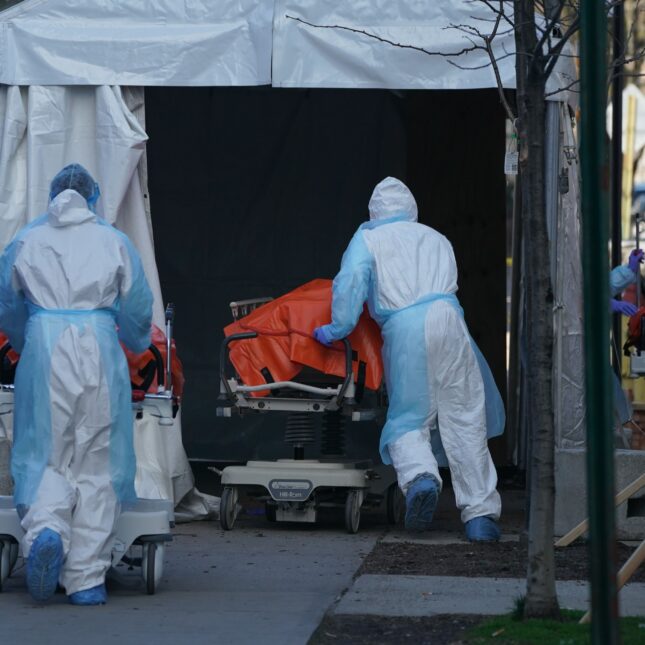
Since its emergence in 2020, Covid has jumbled the list of the 10 leading causes of deaths in the United States. It roared into third place in 2020 but has now fallen to 10th place, the National Center for Health Statistics reported Thursday.
Heart disease and cancer remained the first and second leading causes of death, followed by unintentional injuries as No. 3. Overall, deaths in 2023 were 6.1% lower than 2022.
“We’re going in the wrong direction for heart disease. We’re going a tad in the right direction for cancer,” said Eric Topol, founder and director of the Scripps Research Translational Institute. A cardiologist and geneticist, he was not involved in the analysis. “A lot of things that are highest on this list, there’s a lot of things we can do to prevent them. And hopefully we’ll keep seeing the numbers come down. But if you just look at pre-pandemic to now, it’s not a good trend.”
The report relied on death certificates from 2019 through 2023. Covid-19 was documented as the underlying or contributing cause of 76,446 deaths in 2023, a 68.9% decrease from the year before.
Those related conditions are telling, said Asaf Bitton, a primary care physician and researcher. Executive director of Ariadne Labs, a health systems innovation center at Brigham and Women’s Hospital and the Harvard Chan School of Public Health, he did not participate in the research reported Thursday. Covid killed many elderly people with multiple serious chronic conditions, from kidney disorders to liver disease to Alzheimer’s, he pointed out. Diabetes and heart disease also raised the risk of dying from Covid.
“Covid was an X-ray and magnified the systemic inequities and disparities in our system,” Bitton said. “It also magnified and underscored the incredible burden of chronic conditions in our health system and how our lack of systems that adequately address these major chronic conditions get highlighted when an infection like Covid attacks people with those conditions.”
As Covid deaths fell, unintentional injuries climbed back up to third place. Farida Bhuiya Ahmad, mortality surveillance lead in the division of vital statistics at NCHS and a co-author of a viewpoint on the mortality figures published Thursday in JAMA, told STAT the rise in these accidental deaths is a “major exception” to the otherwise fairly stable trends in leading causes tracked by her agency, part of the Centers for Disease Control and Prevention.
“The rise of accidents, largely driven by drug overdose deaths, has been steady but more gradual than the changes we saw with Covid-19,” she wrote in an email.
That increase in accidental deaths can plausibly be traced to the pandemic, when drug use disorders and alcohol-related diseases surged, the authors argue. Drug and alcohol-related diseases could also push up the tally of chronic liver disease and cirrhosis, they write, now ranked below the top 10 but showing a 15.3% increase from 2019 through 2023.
Topol said more evidence is needed.
“It’s certainly possible that some of these are connected to the pandemic, because we know some of the sequelae are multi-organ and include things like more diabetes, more kidney disease, exacerbation of lung disease, heart disease,” he said. “It’s certainly possible, but speculative.”
In one positive development, Bhuiya Ahmad noted that suicide moved out of the top 10 causes in 2020 and remains that way.
“Heart disease and cancer have consistently ranked as the two leading causes of death, and continue to cause over half a million deaths each per year,” she said.
Stroke deaths climbed into fourth place, in tandem with heart disease, sharing the same dangers from atherosclerosis and clotting problems. Although the rise in death rates from stroke started before Covid, the percentage increases in those rates grew after 2019, another NCHS report released Thursday said.
“Heart disease and stroke, we can do so much more there. These are diseases that take more than two decades to get rooted,” Topol said. “A lot of heart disease and stroke is considered 80% preventable.”
Bitton ties falling life expectancy in the U.S. to a failure to bring timely treatment to patients, starting with primary care.
“We have not been managing our chronic conditions very well over the last five years, including, but not limited to, Covid,” he said. “We know how to deliver better cardiology, outpatient care, and primary care. And we know how to integrate behavioral health into outpatient care. It requires investment, focus, and discipline on the part of a health system to deliver what it ostensibly promises.”
In the absence of a better system for delivering care, he said, ”we’re going to see the rebound of these nasty chronic conditions take their horrible toll, in an inequitable way. And we’re going to basically leave a lot of preventable mortality on the table.”
While Covid-19 is no longer among the top five causes of death, it’s still in the top 10 causes and caused close to 50,000 deaths last year.
“Covid is not going away,” Bitton said. “I mean, it’s bumbling along, and we have to be very mindful of a bird flu event.”
If you or someone you know may be considering suicide, contact the 988 Suicide & Crisis Lifeline: call or text 988 or chat 988lifeline.org. For TTY users: Use your preferred relay service or dial 711 then 988.
STAT’s coverage of chronic health issues is supported by a grant from Bloomberg Philanthropies. Our financial supporters are not involved in any decisions about our journalism.
To submit a correction request, please visit our Contact Us page.











STAT encourages you to share your voice. We welcome your commentary, criticism, and expertise on our subscriber-only platform, STAT+ Connect